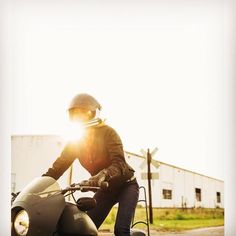 I was walking up the street the other day when a woman cruised by me on a motorcycle, slowed down and pulled over. Some quick calculations went through my mind: she’s wearing yoga pants because she’s a Pilates teacher, I only have one girlfriend in town who rides a motorcycle regularly, she’s about the right height, those are the kind of shoes she would wear, she’s stopping to talk to me.
I was walking up the street the other day when a woman cruised by me on a motorcycle, slowed down and pulled over. Some quick calculations went through my mind: she’s wearing yoga pants because she’s a Pilates teacher, I only have one girlfriend in town who rides a motorcycle regularly, she’s about the right height, those are the kind of shoes she would wear, she’s stopping to talk to me.
I stopped too, knowing that it must be my friend. Still, when she flipped back her visor, I squinted at the rider’s eyes, the only part of her face that I could see. Even though I knew I was right, something told me I was terribly, terribly wrong. Who was this person under the helmet?
Later, we laughed about this, that I hadn’t quite recognized her—something that happens often, she said. But it made me start to wonder—I’d always thought eyes were such an important part of the face. In movies of masquerade balls or bank robberies, I’d always wondered how well these kind of disguises worked. I knew that was Patrick Swayze behind the Ronald Reagan mask, and David Bowie in disguise as a groovy psychedelic satyr.
Of course, it may be that I think I’m better at recognizing people (or actors) than I actually am. This is a common problem—only about 2 percent of people are “super recognizers”, who can memorize faces quickly and recall them many years later, even when they can only see part of the face. In London, the Metropolitan Police Force has a group of officers who are expert at recognizing faces; one of them recognized a rioter whose face was almost completely covered as someone he’d glimpsed in the police station years earlier.
I took several online quizzes to determine what I already knew: I am not a super-recognizer. In fact, I found the quizzes extremely stressful and tiring; my brain felt like it had jumped from lifting balloons to barbells.
The brain is doing a lot of work to recognize faces. There’s a special part of the temporal lobe that’s set aside just for facial recognition. This summer, a team at CalTech studied the neurons that the brain uses to recognize different parts of the face. Some neurons carry information about the shapes of various facial features like the lips and eyes; others track the distance between features. And other neurons are focused on particular qualities: the width of a hairline, for example. The researchers could even re-create a face based on how these neurons fired in the monkeys they were studying.
I do have another friend who I think is a super recognizer. She can spot students that she taught as second-graders twenty years later in a clothing store; she often has to pretend she doesn’t know where she knows a person from when she recognizes them, because she recognizes almost everyone. I wonder if she has more facial recognition neurons, if they fire differently from mine, or if there’s something else going on entirely.
But I do know that I’ll stick close to her the next time I’m at a motorcycle rally. Not only could she help me identify Pilates teachers, neighbors, and friends—she would recognize who I was, pick me out from the crowd. She would know me. And there’s a great comfort in that.
*
Image by BikerKarl2013 via Flickr/Creative Commons license
my brain felt like it had jumped from lifting balloons to barbells.
🙂
as they say on Laugh In: “very interesting”.
Interesting post. I have a few friends who would fall into the category of a super recognizer. It’s a useful skill to have, almost like a photographic memory with facial recognition. I look forward to reading more of your work!